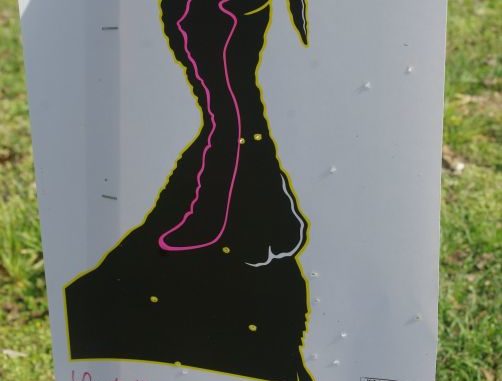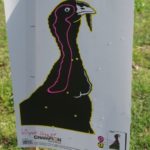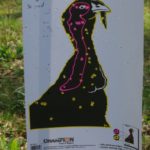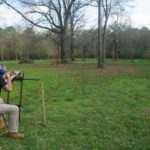
Time on the range with your turkey gun will lead to success in the field
When I went to work for the Louisiana Department of Wildlife and Fisheries in 1976 as a game biologist in the Florida Parishes, I quickly discovered a new species of bird to hunt — the eastern wild turkey.
I had grown up in Northwest Louisiana during the days when turkeys were absent from the landscape. But in Southeast Louisiana, the landscape was filled with turkeys, and thus began a passion for pursuing these magnificent forest birds.
Unfortunately, my shotgun was a Winchester Model 1400 with a 28-inch modified barrel chambered for 2¾-inch shells — a great gun for doves, but I soon found it wasn’t much for killing turkeys.
I did have a couple close enough for my pattern to be effective, but beyond 30 yards I had better not pull the trigger.
I soon purchased a Mossberg 500 pump chambered for 3-inch shells, but it also had a 28-inch modified barrel. It was deadly on ducks at the Atchafalaya Delta and, while it had more firepower than the Winchester, it had limited range.
Consequently, I ordered a 30-inch full-choke barrel for that shotgun, and I had both firepower and range working for me.
The thrill of turkey hunting is matching wits with a tom and trying to get it close enough so one does not worry about range.
But turkey guns today are made for firepower and range, and might lead a hunter to believe he can kill a tom at 100 yards.
My son Ruffin is manager at the gun section at Bowie Outfitters in Baton Rouge, and he talked about shotguns and turkey loads at a seminar in March.
He had spent an afternoon one Sunday shooting various 3-inch and 3½-inch turkey loads from a 20-gauge and 12-gauge shotgun.
The loads included various shot sizes and loads with blended shot. He shot at distances of 30, 40, 50 and 60 yards.
He was using 3-inch shells with the 20-gauge, and at 30 yards there was no difference in the loads he used — all of them put shot in the vital zone of the target.
However, at 40, 50 and 60 yards, it was a totally different story. This Franchi Affinity shotgun had a full-choke tube and, while the number of pellets in the vital zone at 40 yards were fewer than at 30, there were enough to have killed the tom, no matter what load was used.
At 50 and 60 yards, the number of pellets in the vital zone was dramatically reduced. I would not have fired at a turkey with this gun at 50 yards, and I certainly would not shoot at the 60-yard distance.
If the owner of this gun spent time on the range testing available loads, he might find one that would be effective at these ranges. Unfortunately, the average hunter is not going to do this. Most would probably pick a load off the shelf and head to the woods — a major mistake.
I have an old Mossberg bolt-action 20-gauge chambered for 3-inch shells and with an adjustable choke barrel with which I have killed turkeys, but I have passed up shots at 40 yards because it did not pattern well at all at this distance.
I tried a shot once at what I thought was 40 yards only to watch it run off. I followed the tom and saw it running away, and then it took flight so I assumed I had done no harm to it, but you never know.
I also have an old Mossberg bolt-action 12-gauge chambered for 3-inch shells that has a 30-inch barrel with a full choke. It holds the pattern at 40 yards, but beyond this it is weak. I tried a 50-yard shot once with this gun, but the tom simply turned and walked away.
I really like to hunt turkeys with my dad’s old Belgium-made 16-gauge double barrel chambered for 2¾-inch shells: The left barrel is full choke and is deadly at 30 yards, while the right barrel is great for doves.
I have not tried to shoot a turkey with this gun at more than 30 yards, and I never will.
The wild turkey is a large game bird, so at 50 and even 60 yards it appears to be an easy shot — but unless a hunter has spent time shooting his gun and trying different loads, the tom will probably get away.
Ruffin was shooting his Mossberg 12-gauge pump chambered for 3½-inch shells; he has a full choke made for turkeys fitted on the 24-inch barrel. With all loads, it was deadly at 30 and 40 yards; at 50 yards, it was sporadic but there were a few pellets in the vital zone.
Except for one of the 3½-inch loads, this gun was not effective at 60 yards based on the number of pellets in the vital zone.
One thing I noticed when Ruffin was shooting at 50 and 60 yards was that the shot began hitting the ground, kicking up leaves and dirt prior to hitting the target.
At 60 yards, debris began flying up 30 feet in front of the target, somewhat like people doing a wave in a stadium.
While it might be only a millisecond before the pellets hit the target, it certainly would alert a gobbler and the bird might just jerk or turn before arrival of the shot.
At 50 yards, shot was hitting the ground 20 feet in front of the target. I told Ruffin it just wasn’t worth taking a shot that far and risk wounding a tom.
The challenge of turkey hunting is calling in a gobbler. I am not sure a hunter can claim he called in the turkey if he shoots it and kills it at 60 yards. I would put a long shot like this in the category of bush-whacking.
I have measured a few turkey spurs with pellets in the leg and, based on what I saw at the range, these birds were shot at long range. Every year I hear of hunters shooting toms only to have them run off and get away.
Wounds provide an avenue for bacterial infections and while the hunter may not have killed it, the shot could cause secondary problems for the bird, weakening it and perhaps eventually killing it. A long range shot is just not worth it if the end result is a wasted bird.





